
Pierre-Auguste Renoir was a French artist who was a leading painter in the development of the Impressionist style. As a celebrator of beauty and especially feminine sensuality, it has been said that "Renoir is the final representative of a tradition which runs directly from Rubens to Watteau."

Jean-Auguste-Dominique Ingres was a French Neoclassical painter. Ingres was profoundly influenced by past artistic traditions and aspired to become the guardian of academic orthodoxy against the ascendant Romantic style. Although he considered himself a painter of history in the tradition of Nicolas Poussin and Jacques-Louis David, it is his portraits, both painted and drawn, that are recognized as his greatest legacy. His expressive distortions of form and space made him an important precursor of modern art, influencing Picasso, Matisse and other modernists.
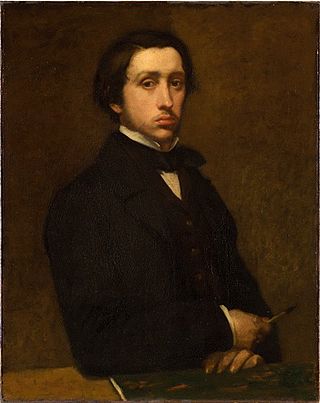
Edgar Degas was a French Impressionist artist famous for his pastel drawings and oil paintings.

Maurice Utrillo, born Maurice Valadon; 26 December 1883 – 5 November 1955), was a French painter of the School of Paris who specialized in cityscapes. From the Montmartre quarter of Paris, France, Utrillo is one of the few famous painters of Montmartre to have been born there.

Suzanne Valadon was a French painter who was born Marie-Clémentine Valadon at Bessines-sur-Gartempe, Haute-Vienne, France. In 1894, Valadon became the first woman painter admitted to the Société Nationale des Beaux-Arts. She was also the mother of painter Maurice Utrillo.
Events from the year 1885 in art.

The Musée de Montmartre is located in Montmartre, at 8-14 rue Cortot in the 18th (XVIII) arrondissement of Paris, France. It was founded in 1960 and was classified as a Musée de France in 2003. The buildings were formerly the home of several famous artists, including Pierre-Auguste Renoir and Suzanne Valadon.
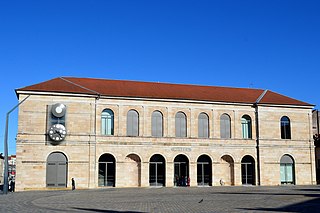
The musée des Beaux-Arts et d'Archéologie in the French city of Besançon is the oldest public museum in France. It was set up in 1694, nearly a century before the Louvre became a public museum.
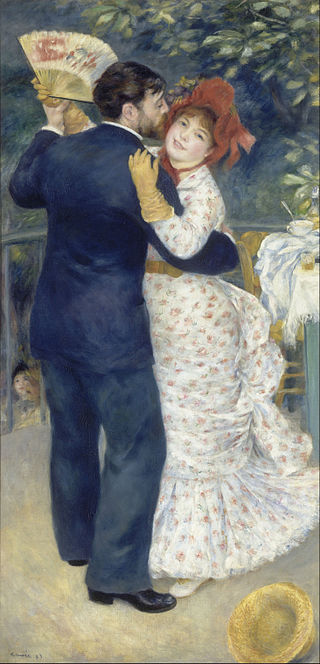
Dance in the Country is an 1883 oil painting by French artist Pierre-Auguste Renoir. It is currently kept at the Musée d'Orsay in Paris.

André Utter was a French painter. He was born in the 18th arrondissement of Paris to parents of Alsatian origin. He is best known for having been the second husband and manager of French painter Suzanne Valadon and the step-father of her son, Maurice Utrillo. The trio have also been called the trinité maudite because of their quarrels, reconciliations, and alcoholism.
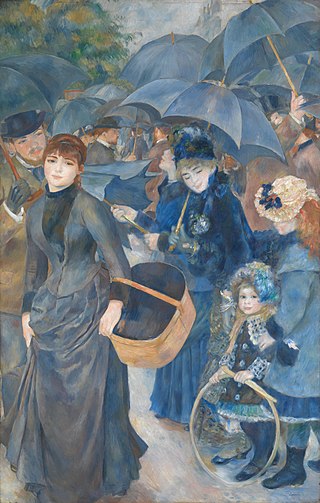
The Umbrellas is an oil-on-canvas painting by Pierre-Auguste Renoir, painted in two phases in the 1880s. It is owned by the National Gallery in London as part of the Lane Bequest but is displayed alternately in London and at the Dublin City Gallery The Hugh Lane. From May 2013 to 2019, it returned to Dublin for a six-year period. It is now in the National Gallery London.

Dance at Bougival is an 1883 oil-on-canvas painting by the French artist Pierre-Auguste Renoir, currently in the collection of the Museum of Fine Arts in Boston, Massachusetts, USA. Described as "one of the museum's most beloved works", it is one of three in a collection commissioned by Paul Durand-Ruel. It depicts a scene in the French village of Bougival, about 15 km from the center of Paris, a site utilized by many Impressionists besides Renoir including Claude Monet, Alfred Sisley, and Berthe Morisot.

Dance in the City is a painting by French artist Pierre-Auguste Renoir. The 1883 work is in the collection of the Musée d'Orsay. The dancers are model and artist Suzanne Valadon and Renoir's friend Paul Auguste Lhôte.

Lise Tréhot was a French art model who posed for artist Pierre-Auguste Renoir from 1866 until 1872, during his early Salon period. She appeared in more than twenty paintings, including notable works such as Lise with a Parasol (1867) and In Summer (1868), and she was the model for almost all of Renoir's work featuring female figures at this time. Tréhot married Georges Brière de l'Isle in 1883 and raised four children to whom she bequeathed two of Renoir's paintings, Lise Sewing (1867–68) and Lise in a White Shawl (1872), both of which are currently held by the Dallas Museum of Art.

La Promenade is an oil on canvas, early Impressionist painting by the French artist Pierre-Auguste Renoir, created in 1870. The work depicts a young couple on an excursion outside of the city, walking on a path through a woodland. Influenced by the rococo revival style during the Second Empire, Renoir's La Promenade reflects the older style and themes of eighteenth-century artists like Jean-Honoré Fragonard and Jean-Antoine Watteau. The work also shows the influence of Claude Monet on Renoir's new approach to painting.

Lise with a Parasol is an oil on canvas painting by French artist Pierre-Auguste Renoir, created in 1867 during his early Salon period. The full-length painting depicts model Lise Tréhot posing in a forest. She wears a white muslin dress and holds a black lace parasol to shade her from the sunlight, which filters down through the leaves, contrasting her face in the shadow and her body in the light, highlighting her dress rather than her face. After having several paintings rejected by the Salon, Renoir's Lise with a Parasol was finally accepted and exhibited in May 1868.
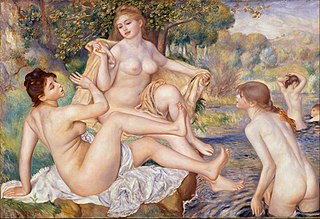
Les Grandes Baigneuses, or The Large Bathers, is a painting by Pierre-Auguste Renoir made between 1884 and 1887. The painting is in the Philadelphia Museum of Art, in Philadelphia.

Blonde Bather is the name of two very similar paintings by French painter Pierre-Auguste Renoir, created in 1881 and 1882. The model was Aline Charigot, later to become Renoir's wife. Influenced by Renaissance painting that Renoir saw in Italy in 1881, both paintings show a marked change of style from Renoir's previous work. Some commentators consider these are works of great beauty, others that they are vulgar. There has been criticism of the conservation work performed on the 1881 painting.

Aline Victorine Charigot was a model for Auguste Renoir and later became his wife while continuing to model for him and then caring for him when he became disabled. She is pictured in many of his paintings over very many years, most famously in the early 1880s Luncheon of the Boating Party, and Blonde Bather. They had three children together, two of whom, Pierre and Jean, went on to have distinguished careers in film, and the third, Claude, became a ceramic artist. Pierre had a son Claude who became the well-known cinematographer. She predeceased her elderly husband.

Diana is a painting from 1867 by the French painter Pierre-Auguste Renoir. It is thought to depict the painter's lover Lise Tréhot as the Roman goddess Diana, although the exact identification of the model in the painting is disputed by art historians.



















